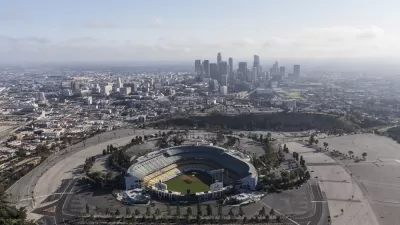In renovating Dodger Stadium to enhance the fan experience, the baseball team's ownership brought together a team of architects and planners known for integrating stadiums into the urban fabric of their surroundings.
The Planning Report features the second in a series of interviews with Los Angeles Dodgers management and design team as the owners rush to finish a series of improvements and renovations ahead of opening day. Brenda Levin of Levin & Associates Architects, Tommy Quirk of DAIQ, and Mia Lehrer of Mia Lehrer + Associates were charged with executing more than $100 million in improvements and enhancements over the course of several months. The Planning Report sat down with Tommy Quirk to discuss how improving the fan experience became the central ethos of the project, even in their approach to redesigning the team clubhouse.
An interactive graphic in the Los Angeles Times details the ambitious renovation project.
DAIQ Architects has partnered extensively with Janet Marie Smith, now Senior Vice President of Planning and Development for the Los Angeles Dodgers, on projects ranging from Boston's Fenway Park to Atlanta's Turner Field. In all cases, Smith and Quirk's teams have focused on the relationship between the stadium and the its surrounding urban fabric. In the case of Fenway Park, the stadium is set in the middle of a dense urban landscape, and walking through the Fenway neighborhood becomes part of the cherished baseball experience. While the Chavez Ravine may feel relatively removed from Los Angeles' neighborhoods, Dodgers architects examined ways of translating that sense of pedestrian space to the stadium's context.
As Quirk notes, "The team is the primary focus of the fan experience; the fans are here to see the ball team. But then the experiences around the game are basically what we were charged with addressing. In every case, we were asked (even our firm that’s doing mostly work related to the ball team) to think about all of the spaces and the procession of spaces as you enter a facility."
FULL STORY: Dodger Stadium Architectural Team Met Opening Day Challenges

Planetizen Federal Action Tracker
A weekly monitor of how Trump’s orders and actions are impacting planners and planning in America.

Maui's Vacation Rental Debate Turns Ugly
Verbal attacks, misinformation campaigns and fistfights plague a high-stakes debate to convert thousands of vacation rentals into long-term housing.

San Francisco Suspends Traffic Calming Amidst Record Deaths
Citing “a challenging fiscal landscape,” the city will cease the program on the heels of 42 traffic deaths, including 24 pedestrians.

Amtrak Rolls Out New Orleans to Alabama “Mardi Gras” Train
The new service will operate morning and evening departures between Mobile and New Orleans.

The Subversive Car-Free Guide to Trump's Great American Road Trip
Car-free ways to access Chicagoland’s best tourist attractions.

San Antonio and Austin are Fusing Into one Massive Megaregion
The region spanning the two central Texas cities is growing fast, posing challenges for local infrastructure and water supplies.
Urban Design for Planners 1: Software Tools
This six-course series explores essential urban design concepts using open source software and equips planners with the tools they need to participate fully in the urban design process.
Planning for Universal Design
Learn the tools for implementing Universal Design in planning regulations.
Heyer Gruel & Associates PA
JM Goldson LLC
Custer County Colorado
City of Camden Redevelopment Agency
City of Astoria
Transportation Research & Education Center (TREC) at Portland State University
Jefferson Parish Government
Camden Redevelopment Agency
City of Claremont



























